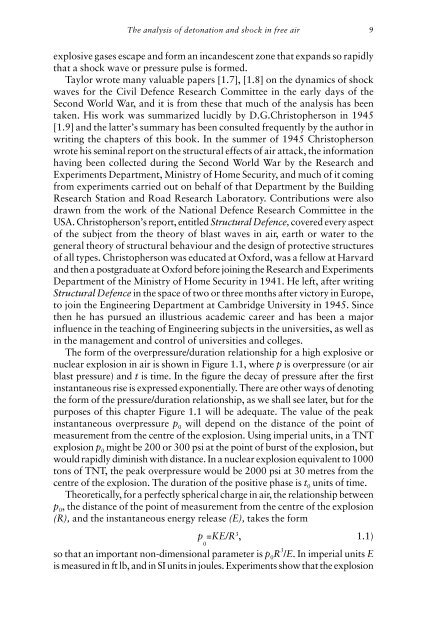A History of Research and a Review of Recent Developments
A History of Research and a Review of Recent Developments
A History of Research and a Review of Recent Developments
Create successful ePaper yourself
Turn your PDF publications into a flip-book with our unique Google optimized e-Paper software.
The analysis <strong>of</strong> detonation <strong>and</strong> shock in free air 9<br />
explosive gases escape <strong>and</strong> form an inc<strong>and</strong>escent zone that exp<strong>and</strong>s so rapidly<br />
that a shock wave or pressure pulse is formed.<br />
Taylor wrote many valuable papers [1.7], [1.8] on the dynamics <strong>of</strong> shock<br />
waves for the Civil Defence <strong>Research</strong> Committee in the early days <strong>of</strong> the<br />
Second World War, <strong>and</strong> it is from these that much <strong>of</strong> the analysis has been<br />
taken. His work was summarized lucidly by D.G.Christopherson in 1945<br />
[1.9] <strong>and</strong> the latter’s summary has been consulted frequently by the author in<br />
writing the chapters <strong>of</strong> this book. In the summer <strong>of</strong> 1945 Christopherson<br />
wrote his seminal report on the structural effects <strong>of</strong> air attack, the information<br />
having been collected during the Second World War by the <strong>Research</strong> <strong>and</strong><br />
Experiments Department, Ministry <strong>of</strong> Home Security, <strong>and</strong> much <strong>of</strong> it coming<br />
from experiments carried out on behalf <strong>of</strong> that Department by the Building<br />
<strong>Research</strong> Station <strong>and</strong> Road <strong>Research</strong> Laboratory. Contributions were also<br />
drawn from the work <strong>of</strong> the National Defence <strong>Research</strong> Committee in the<br />
USA. Christopherson’s report, entitled Structural Defence, covered every aspect<br />
<strong>of</strong> the subject from the theory <strong>of</strong> blast waves in air, earth or water to the<br />
general theory <strong>of</strong> structural behaviour <strong>and</strong> the design <strong>of</strong> protective structures<br />
<strong>of</strong> all types. Christopherson was educated at Oxford, was a fellow at Harvard<br />
<strong>and</strong> then a postgraduate at Oxford before joining the <strong>Research</strong> <strong>and</strong> Experiments<br />
Department <strong>of</strong> the Ministry <strong>of</strong> Home Security in 1941. He left, after writing<br />
Structural Defence in the space <strong>of</strong> two or three months after victory in Europe,<br />
to join the Engineering Department at Cambridge University in 1945. Since<br />
then he has pursued an illustrious academic career <strong>and</strong> has been a major<br />
influence in the teaching <strong>of</strong> Engineering subjects in the universities, as well as<br />
in the management <strong>and</strong> control <strong>of</strong> universities <strong>and</strong> colleges.<br />
The form <strong>of</strong> the overpressure/duration relationship for a high explosive or<br />
nuclear explosion in air is shown in Figure 1.1, where p is overpressure (or air<br />
blast pressure) <strong>and</strong> t is time. In the figure the decay <strong>of</strong> pressure after the first<br />
instantaneous rise is expressed exponentially. There are other ways <strong>of</strong> denoting<br />
the form <strong>of</strong> the pressure/duration relationship, as we shall see later, but for the<br />
purposes <strong>of</strong> this chapter Figure 1.1 will be adequate. The value <strong>of</strong> the peak<br />
instantaneous overpressure p 0 will depend on the distance <strong>of</strong> the point <strong>of</strong><br />
measurement from the centre <strong>of</strong> the explosion. Using imperial units, in a TNT<br />
explosion p 0 might be 200 or 300 psi at the point <strong>of</strong> burst <strong>of</strong> the explosion, but<br />
would rapidly diminish with distance. In a nuclear explosion equivalent to 1000<br />
tons <strong>of</strong> TNT, the peak overpressure would be 2000 psi at 30 metres from the<br />
centre <strong>of</strong> the explosion. The duration <strong>of</strong> the positive phase is t 0 units <strong>of</strong> time.<br />
Theoretically, for a perfectly spherical charge in air, the relationship between<br />
p 0, the distance <strong>of</strong> the point <strong>of</strong> measurement from the centre <strong>of</strong> the explosion<br />
(R), <strong>and</strong> the instantaneous energy release (E), takes the form<br />
1.1)<br />
so that an important non-dimensional parameter is p0R 3 p =KE/R<br />
0<br />
/E. In imperial units E<br />
is measured in ft lb, <strong>and</strong> in SI units in joules. Experiments show that the explosion<br />
3 ,


